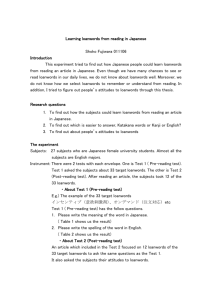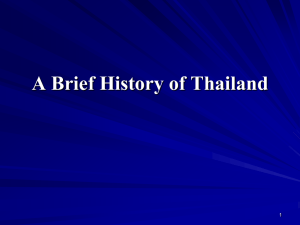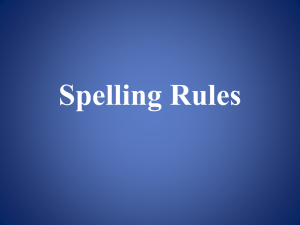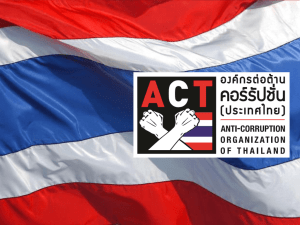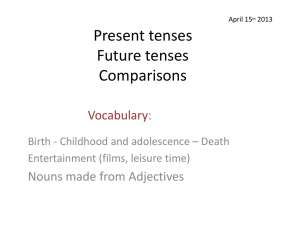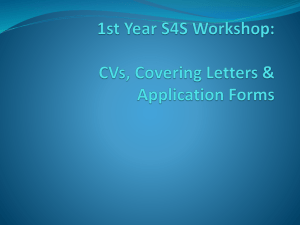Thai Tones in English Loanwords
advertisement
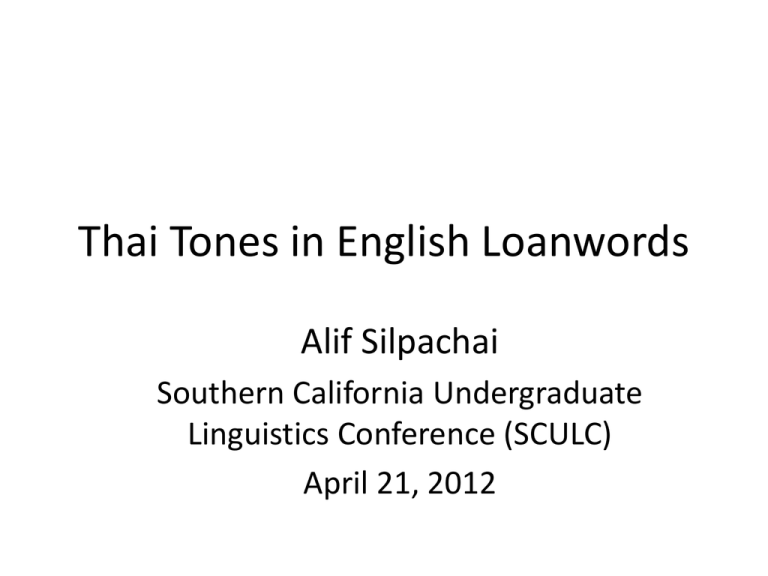
Thai Tones in English Loanwords Alif Silpachai Southern California Undergraduate Linguistics Conference (SCULC) April 21, 2012 Preview – Compare sources with a native speaker • What my sources claim regarding Thai tones in English loanwords • What my sources missed • What should be added Background: Standard Thai • Standard Thai, or Siamese, a Tai-Kadai language, is a tone language spoken mainly in Thailand. • There are five phonemic tones in Thai. Where is Thai(Siamese) Spoken? Bangkok Background: Speaker for this Paper • Me – I am a native speaker of Standard Thai – I can read and write Thai. – I have more English loanwords in my lexicon. – English loanwords have “Thai tones”. Sources • Gandour (1976) – General tonal patterns in English loanwords. • Kenstowicz & Suchato (2006) – Based on the work of Gandour (1976): an updated version of Gandour’s paper. Five Phonemic Tones in Thai Name Chao Letters Example Gloss Mid 32 kʰaa To be stuck Low 21 kʰàa Galangal Falling 51 kʰâa To kill High 45 kʰáa To trade Rising 24 kʰǎa leg Tones in Praat Mid 32 Low 21 High 45 Falling 51 Rising 24 Goals of Study • To see which tones get selected in English loanwords according to my sources. • To explain the tonal rules in these loanwords, using the OT. • To explain why only some tones are used in English loanwords. • To see whether my pronunciation matches the description of my sources. If not, the goal is to suggest ways in which my sources be updated. Distribution of Tones • C = consonant • V = vowel – VV = long vowel • O = obstruent – p, t, k, b, d, ʔ etc. • S = sonorant – m, n, ŋ, l, w, j etc. Distribution of Tones in Native Words Syllable type Tones allowed Word Example Hence… CVV, CVVS, CVS all five tones khaa, khaaw, khaw CVVO Falling and Low maak *maak32 *máak45 *mǎak24 CVO Low and High mak *mak32 *mâk51 *mǎk24 Distribution of Tones Syllable type Tones allowed Word examples English Loans Native words CVV, CVVS, CVS Mid and Falling All five tones khaa, khaaw, khaw CVVO High and Low Falling and Low maak CVO High, Low, and Falling Low and High mak Monosyllabic Words Tones in Monosyllabic Words Syllable type English loanwords English CVV, CVVS, CVS baa32 bar faam32 farm thəəm32 term OT Analysis This tableau shows that *RISEHIGHLOWFALL/CVS must outrank DON’THAVETONE. /baa/ TONE *RISEHIGHLOWFALL/CVS ☞ baa32 DON’THAVETONE * báa45 *! * bàa21 *! * bâa51 *! * bǎa24 *! * baa *! Tones in Monosyllabic Words Syllable type English loanwords English CVVO pháak45 park bɔ́ɔt45 boss fɔ̀ɔt21 Ford bík45 big ʔâp51 up CVO OT Analysis The tableau shows that *MIDRISE/CVO must outrank DON’THAVETONE, but does not dominate *RISEHIGHLOWFALL/CVS. /bɔɔt/ TONE *RISEHIGHLOWFALL/CVS *MIDRISE/CVO ☞bɔɔ́ t 45 DON’THAVETONE * bɔɔt 32 *! * bɔ̌ɔt 24 *! * bɔɔt *! Opacity Syllable type English loanwords English Covert CVSO bɛ́ŋ45 bank khɛ́m45 camp náj45 night Opacity Input /bæŋk/ /bæŋk/ assign High tone to CVSO delete final obstruent bɛŋ́ k45 delete final obstruent bɛŋ32 bɛŋ́ 45 assign High tone to CVSO -- Output [bɛŋ́ 45] *[bɛŋ32] OT Analysis Stem Level *MIDRISE/CVO, MAX-C >>*COMPLEXCODA Lexical Level *COMPLEXCODA, DON’TCHANGETONE >> *MIDRISE/CVO, MAX-C. Stem Level DON’THAVETONE ☞béwt 45 *COMPLEXCODA MAX-C *MIDRISE/CVO *RISEHIGHLOWFALL/C VS /bewt/ DON’TCHANGETONE TONE The tableau shows that *MIDRISE/CVO and MAX-C must dominate *COMPLEXCODA. * * bewt 32 *! * * běwt 24 *! * * bewt béw45 bew32 * *! *! * * *! * Lexical Level / béwt 45/ ☞béw 45 béwt 45 běw 24 * DON’THAVETONE MAX-C * *! * * *! * * * * bew *! bew32 *MIDRISE/CVO *RISEHIGHLOWFALL/CVS DON’TCHANGETONE *COMPLEXCODA TONE This tableau shows that at the lexical level, *COMPLEXCODA and DON’TCHANGETONE must dominate MAX-C and MIDRISE/CVO. *! * * Opacity? Syllable type CVSO(?) English loanwords English blɔn32 blonde brɛɛn32 brand fiw32 fuse Polysyllabic Words Tones in Polysyllabic Words Final syllable type CVV, CVVS, CVS English loanwords English wii32.sâa51 vísa fɛɛ32.chân51 fáshion dɔn32.lâa51 dóllar Tones in Polysyllabic Words Kenstowicz & Suchato (2006, page 940) OT Analysis /wíiH.sàaL/ ALIGN(H, R; WORD, R) MAX-H MAX-L ☞ wii.sâaHL wíiH.sàaL *! *! * *! wii.sáaH * *! *! wìiL.saa wîiHL.saa NE * wii.sàaL wíiH.saa DON’TCHANGETO *! * * * * Tones in Polysyllabic Words Final syllable type CVO, CVVO English loanwords English búk45.lèt21 booklet boo32.nát45 bonus méek45 Ɂâp51 make up OT Analysis ALIGN(H, R; WORD, R) *HL/CVO MAX-H MAX-L / bóoH.nàtL/ ☞ boo.nátH * *! bóoH.nàtL boo.nâtHL boo.nàtL *! *! The Patterns We Have Learned Type of Word Syllable Type Monosyllabic Type of Word Polysyllabic Example Gloss CVV, CVVS, CVS Mid baa32 bar CVVO High, Low bɔ́ɔt45 boss CVO High, Low, Falling bík45 big Final Syllable Type Tone(s) Tone(s) Example Gloss CVV, CVVS, CVS Falling phaw32.wə̂ə51 power CVVO, CVO Low, High búk45.lèt21 booklet My Speech • Largely agrees with the description of my sources. • But… My Speech Expected forms my pronunciation gloss *mii32.dîa51 mii32.dìa21 media *maa32.fîa51 maa32.fia32 mafia My Speech OT Analysis ALIGN(H, R; WORD, R) *HL/Cia *HL/CVO MAX-H MAX-L * * /máaH.fìaL/ ☞ maa.fia *! maa.fíaH * *! maa.fîaHL *! máaH.fìaL Summary • Analysis of the Sources – My pronunciation largely agrees with my sources, except for the polysyllabic words terminating in –ia
